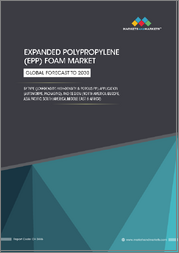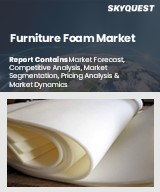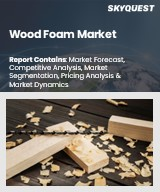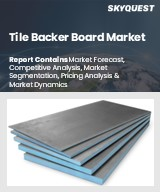
|
시장보고서
상품코드
1608091
세계의 산업용 폼 시장 : 폼 유형, 수지 유형, 용도별 예측(2025-2030년)Industrial Foam Market by Foam Type (Flexible, Rigid), Resin Type (Phenolic, Polyethylene Terephthalate, Polyolefin), Application - Global Forecast 2025-2030 |
||||||
산업용 폼 시장의 2023년 시장 규모는 589억 4,000만 달러로 평가되었습니다. 2024년에는 611억 2,000만 달러에 달할 것으로 예측되며, 복합 연간 성장률(CAGR) 5.34%로 성장하여, 2030년에는 848억 6,000만 달러에 달할 것으로 예상됩니다.
산업용 폼에는 경량이고 내구성이 있으며, 많은 산업에서 사용되는 다목적 재료로 가공된 다양한 폴리머가 포함되어 있습니다. 분야의 단열, 쿠션, 씰, 충격 흡수 등 여러 용도에 걸쳐 있습니다.산업용 폼의 필요성은 저밀도, 우수한 단열성, 방음성, 내충격성 등의 특성으로부터 생겨, 최종 용도 제품의 에너지 효율, 안전성, 성능을 높이는데 있어서 매우 중요 한 역할을 수행합니다. 시장의 성장은 에너지 효율입니다. 높은 솔루션에 대한 수요 증가, 급속한 산업화, 근대화, 지속 가능한 그린 빌딩 구상의 대두에 의해 뒷받침되고 있습니다. 새로운용 도 등을 들 수 있습니다.자동차 업계나 건설 업계에서는 경량으로 내구성이 있어, 친환경 소재를 요구하는 제조업체가 증가하고 있어 기업은 뛰어난 성능과 지속가능성을 제공하는 혁신적인 제품 개발하여 이러한 기회를 활용할 수 있습니다.
| 주요 시장 통계 | |
|---|---|
| 기준년(2023) | 589억 4,000만 달러 |
| 추정년(2024) | 611억 2,000만 달러 |
| 예측년(2030) | 848억 6,000만 달러 |
| 복합 연간 성장률(CAGR)(%) | 5.34% |
그러나 시장 성장은 원재료 가격 변동, 환경 영향 및 건강 안전과 관련된 엄격한 규제 기준과 같은 제약과 과제에 직면 해 있습니다. 제공하기 때문에 가격 압력으로 이어질 수 있습니다.
이 분야의 기술 혁신은 생분해성, 재활용 가능한 발포체 개발, 가혹한 조건 하에서 발포체의 내구성 및 성능 향상, 다양한 용도에서 기능성 향상을 위한 스마트 기술 통합 에 초점을 맞출 수 있습니다. 또한 나노 기술 조사는 양식의 특성에 혁명을 가져와 새로운 시장을 개설 탁월할 수 있습니다. 시장 역학은 역동적이며 기술의 진보와 지속가능성에 대한 소비자의 기호의 진화에 힘쓰고 있습니다. 유지할 수 있을 뿐만 아니라 차세대 솔루션 수요에 대응함으로써 시장 점유율을 획득할 수 있을 가능성도 있습니다.
시장 역학 : 빠르게 진화하는 산업용 폼 시장의 주요 시장 인사이트 공개
산업용 폼 시장은 수요 및 공급의 역동적인 상호작용에 의해 변모를 이루고 있습니다. 새로운 비즈니스 기회를 얻는 데 도움이 될 수 있습니다. 이러한 동향을 종합적으로 파악함으로써 기업은 정치적, 지리적, 기술적, 사회적, 경제적 영역에 걸친 다양한 리스크를 경감할 수 있음과 동시에 소비자 행동과 그것 제조 비용과 구매 동향에 미치는 영향을보다 명확하게 이해할 수 있습니다.
- 시장 성장 촉진요인
- 자동차 생산, 판매의 급증
- 건축 및 건설 분야에 대한 투자 증가
- 대음량의 산업 기기에 있어서의 산업용 폼의 이용
- 시장 성장 억제요인
- 원재료 가격 변동
- 시장 기회
- 바이오 폴리올 개발
- 생산과 사용에 있어서의 지속가능성에 대한 관심 증가
- 시장의 과제
- 산업용 폼과 관련된 문제
Porter's Five Forces : 산업용 폼 시장을 탐색하는 전략 도구
Porter's Five Forces Framework는 산업용 폼 시장 경쟁 구도를 이해하는 중요한 도구입니다. Porter's Five Forces Framework는 기업의 경쟁력을 평가하고 전략적 기회를 탐구하는 명확한 기술을 제공합니다. 이 프레임워크는 기업이 시장 내 세력도를 평가하고 신규 사업의 수익성을 판단하는 데 도움이 됩니다. 이러한 인사이트을 통해 기업은 자사의 강점을 활용하고 약점을 해결하고 잠재적인 과제를 피함으로써 보다 강인한 시장에서의 포지셔닝을 확보할 수 있습니다.
PESTLE 분석 : 산업용 폼 시장에서 외부 영향을 파악
외부 거시 환경 요인은 산업 양식 시장의 성과 역학을 형성하는 데 매우 중요한 역할을합니다. 정치적, 경제적, 사회적, 기술적, 법적, 환경적 요인 분석은 이러한 영향을 탐색하는 데 필요한 정보를 제공합니다. PESTLE 요인을 조사함으로써 기업은 잠재적인 위험과 기회를 더 잘 이해할 수 있습니다. 이 분석을 통해 기업은 규제, 소비자 선호, 경제 동향의 변화를 예측하고 앞으로 예상되는 적극적인 의사 결정을 할 준비가 가능합니다.
시장 점유율 분석 산업용 폼 시장 경쟁 구도 파악
산업용 폼 시장의 상세한 시장 점유율 분석을 통해 공급업체의 성과를 종합적으로 평가할 수 있습니다. 기업은 수익, 고객 기반, 성장률 등 주요 지표를 비교하여 경쟁 포지셔닝을 밝힐 수 있습니다. 이 분석을 통해 시장 집중, 단편화, 통합 동향을 밝혀내고 벤더들은 경쟁이 치열해지는 가운데 자사의 지위를 높이는 전략적 의사 결정을 내리는 데 필요한 지식을 얻을 수 있습니다.
FPNV 포지셔닝 매트릭스 산업용 폼 시장에서 공급업체의 성능 평가
FPNV 포지셔닝 매트릭스는 산업용 폼 시장에서 벤더를 평가하는 중요한 도구입니다. 이 행렬을 통해 비즈니스 조직은 공급업체의 비즈니스 전략과 제품 만족도를 기준으로 평가하여 목표에 맞는 충분한 정보를 바탕으로 의사 결정을 내릴 수 있습니다. 네 가지 사분면을 통해 공급업체를 명확하고 정확하게 세분화하여 전략 목표에 가장 적합한 파트너 및 솔루션을 파악할 수 있습니다.ㅇ
전략 분석 및 권장 산업용 폼 시장에서 성공에 대한 길을 그립니다.
산업용 폼 시장의 전략 분석은 시장에서의 프레즌스 강화를 목표로 하는 기업에 필수적인 요소입니다. 이 접근법을 통해 경쟁 구도에서 과제를 극복하고 새로운 비즈니스 기회를 활용하여 장기적인 성공을 거둘 수 있는 체제를 구축할 수 있습니다.
이 보고서는 주요 관심 분야를 포괄하는 시장의 종합적인 분석을 제공합니다.
1. 시장 침투 : 현재 시장 환경의 상세한 검토, 주요 기업의 광범위한 데이터, 시장 도달범위 및 전반적인 영향력 평가.
2. 시장 개척도 : 신흥 시장의 성장 기회를 파악하고 기존 분야의 확장 가능성을 평가하며 미래 성장을 위한 전략적 로드맵을 제공합니다.
3. 시장 다양화 : 최근 제품 출시, 미개척 지역, 업계의 주요 진보, 시장을 형성하는 전략적 투자를 분석합니다.
4. 경쟁 평가 및 정보 : 경쟁 구도를 철저히 분석하여 시장 점유율, 사업 전략, 제품 포트폴리오, 인증, 규제 당국 승인, 특허 동향, 주요 기업의 기술 진보 등을 검증합니다.
5. 제품 개발 및 혁신 : 미래 시장 성장을 가속할 것으로 예상되는 최첨단 기술, R&D 활동, 제품 혁신을 강조합니다.
또한 이해관계자가 충분한 정보를 얻고 의사결정을 할 수 있도록 중요한 질문에 대답하고 있습니다.
1. 현재 시장 규모와 향후 성장 예측은?
2. 최고의 투자 기회를 제공하는 제품, 부문 및 지역은 어디입니까?
3. 시장을 형성하는 주요 기술 동향과 규제의 영향은?
4. 주요 벤더의 시장 점유율과 경쟁 포지션은?
5. 벤더 시장 진입, 철수 전략의 원동력이 되는 수익원과 전략적 기회는 무엇인가?
목차
제1장 서문
제2장 조사 방법
제3장 주요 요약
제4장 시장 개요
제5장 시장 인사이트
- 시장 역학
- 성장 촉진요인
- 자동차 생산과 판매의 급증
- 건축 및 건설 분야에 대한 투자 증가
- 소음이 큰 산업 기기에 있어서의 산업용 폼의 이용
- 억제요인
- 원재료 가격 변동
- 기회
- 바이오 베이스 폴리올의 개발
- 산업용 폼 생산과 사용에 있어서의 지속가능성에 대한 주목의 고조
- 과제
- 산업용 폼과 관련된 문제
- 성장 촉진요인
- 시장 세분화 분석
- Porter's Five Forces 분석
- PESTEL 분석
- 정치적
- 경제
- 사교
- 기술적
- 법률상
- 환경
제6장 산업용 폼 시장 : 폼 유형별
- 유연한
- 딱딱한
제7장 산업용 폼 시장 : 수지 유형별
- 페놀
- 폴리에틸렌테레프탈레이트
- 폴리올레핀
- 폴리스티렌
- 폴리우레탄
제8장 산업용 폼 시장 : 용도별
- 건축 및 건설
- 식품 및 음료
- 산업용 냉장 창고
- 섬유
- 교통기관
제9장 아메리카의 산업용 폼 시장
- 아르헨티나
- 브라질
- 캐나다
- 멕시코
- 미국
제10장 아시아태평양의 산업용 폼 시장
- 호주
- 중국
- 인도
- 인도네시아
- 일본
- 말레이시아
- 필리핀
- 싱가포르
- 한국
- 대만
- 태국
- 베트남
제11장 유럽, 중동 및 아프리카의 산업용 폼 시장
- 덴마크
- 이집트
- 핀란드
- 프랑스
- 독일
- 이스라엘
- 이탈리아
- 네덜란드
- 나이지리아
- 노르웨이
- 폴란드
- 카타르
- 러시아
- 사우디아라비아
- 남아프리카
- 스페인
- 스웨덴
- 스위스
- 터키
- 아랍에미리트(UAE)
- 영국
제12장 경쟁 구도
- 시장 점유율 분석(2023년)
- FPNV 포지셔닝 매트릭스(2023년)
- 경쟁 시나리오 분석
- 전략 분석과 제안
기업 목록
- Arkema Group
- BASF SE
- Covestro AG
- Foamcraft, Inc.
- Huntsman Corporation
- LANXESS AG
- Loyal Chemical Industrial Corporation
- NEVEON Holding GmbH
- Polymer Technologies, Inc.
- Recticel Group
- Rogers Corporation
- Saint-Gobain Group
- Sealed Air Corporation
- SEKISUI CHEMICAL CO. LTD.
- Woodbridge Foam Corporation
The Industrial Foam Market was valued at USD 58.94 billion in 2023, expected to reach USD 61.12 billion in 2024, and is projected to grow at a CAGR of 5.34%, to USD 84.86 billion by 2030.
Industrial foam encompasses a variety of polymers engineered into lightweight, durable, and versatile materials used across numerous industries. This market spans several applications, including insulation, cushioning, sealing, and shock absorption in sectors like construction, automotive, packaging, and appliances. The necessity of industrial foam arises from its properties-such as low density, excellent thermal insulation, acoustic isolation, and impact resistance-making it crucial in enhancing energy efficiency, safety, and performance in the end-use products. The market's growth is propelled by increasing demand for energy-efficient solutions, rapid industrialization, and modernization, coupled with the rise of sustainable and green building initiatives. Key growth factors include advancements in foam technology, such as bio-based and recycled materials, and new applications in emerging markets. Opportunities abound in the expanding automotive and construction industries, where manufacturers increasingly seek lightweight, durable, and environmentally friendly materials; businesses can tap into this by developing innovative products that offer superior performance and sustainability.
| KEY MARKET STATISTICS | |
|---|---|
| Base Year [2023] | USD 58.94 billion |
| Estimated Year [2024] | USD 61.12 billion |
| Forecast Year [2030] | USD 84.86 billion |
| CAGR (%) | 5.34% |
However, market growth faces limitations and challenges, including fluctuating raw material prices and stringent regulatory norms regarding environmental impact and health safety. Additionally, the market is highly competitive with numerous players offering diverse solutions, which might lead to pricing pressures.
Innovation in this sector can focus on the development of biodegradable and recyclable foams, enhancing foam durability and performance under extreme conditions, and integrating smart technology for better functionality in various applications. Additionally, research into nanotechnology could revolutionize foam properties and open up new markets. The nature of the industrial foam market is dynamic and driven by technological advancements and evolving consumer preferences towards sustainability. Companies that prioritize R&D to align with these trends will not only stay competitive but also potentially capture market share by addressing the demand for next-generation solutions.
Market Dynamics: Unveiling Key Market Insights in the Rapidly Evolving Industrial Foam Market
The Industrial Foam Market is undergoing transformative changes driven by a dynamic interplay of supply and demand factors. Understanding these evolving market dynamics prepares business organizations to make informed investment decisions, refine strategic decisions, and seize new opportunities. By gaining a comprehensive view of these trends, business organizations can mitigate various risks across political, geographic, technical, social, and economic domains while also gaining a clearer understanding of consumer behavior and its impact on manufacturing costs and purchasing trends.
- Market Drivers
- Surging production and sales of automotives
- Increasing investments in the building & construction sectors
- Utilization of industrial foams in loud industrial equipment
- Market Restraints
- Price volatility of raw materials
- Market Opportunities
- Development of bio-based polyols
- Rising focus on sustainability in industrial foam production and usage
- Market Challenges
- Problems associated with industrial foam
Porter's Five Forces: A Strategic Tool for Navigating the Industrial Foam Market
Porter's five forces framework is a critical tool for understanding the competitive landscape of the Industrial Foam Market. It offers business organizations with a clear methodology for evaluating their competitive positioning and exploring strategic opportunities. This framework helps businesses assess the power dynamics within the market and determine the profitability of new ventures. With these insights, business organizations can leverage their strengths, address weaknesses, and avoid potential challenges, ensuring a more resilient market positioning.
PESTLE Analysis: Navigating External Influences in the Industrial Foam Market
External macro-environmental factors play a pivotal role in shaping the performance dynamics of the Industrial Foam Market. Political, Economic, Social, Technological, Legal, and Environmental factors analysis provides the necessary information to navigate these influences. By examining PESTLE factors, businesses can better understand potential risks and opportunities. This analysis enables business organizations to anticipate changes in regulations, consumer preferences, and economic trends, ensuring they are prepared to make proactive, forward-thinking decisions.
Market Share Analysis: Understanding the Competitive Landscape in the Industrial Foam Market
A detailed market share analysis in the Industrial Foam Market provides a comprehensive assessment of vendors' performance. Companies can identify their competitive positioning by comparing key metrics, including revenue, customer base, and growth rates. This analysis highlights market concentration, fragmentation, and trends in consolidation, offering vendors the insights required to make strategic decisions that enhance their position in an increasingly competitive landscape.
FPNV Positioning Matrix: Evaluating Vendors' Performance in the Industrial Foam Market
The Forefront, Pathfinder, Niche, Vital (FPNV) Positioning Matrix is a critical tool for evaluating vendors within the Industrial Foam Market. This matrix enables business organizations to make well-informed decisions that align with their goals by assessing vendors based on their business strategy and product satisfaction. The four quadrants provide a clear and precise segmentation of vendors, helping users identify the right partners and solutions that best fit their strategic objectives.
Strategy Analysis & Recommendation: Charting a Path to Success in the Industrial Foam Market
A strategic analysis of the Industrial Foam Market is essential for businesses looking to strengthen their global market presence. By reviewing key resources, capabilities, and performance indicators, business organizations can identify growth opportunities and work toward improvement. This approach helps businesses navigate challenges in the competitive landscape and ensures they are well-positioned to capitalize on newer opportunities and drive long-term success.
Key Company Profiles
The report delves into recent significant developments in the Industrial Foam Market, highlighting leading vendors and their innovative profiles. These include Arkema Group, BASF SE, Covestro AG, Foamcraft, Inc., Huntsman Corporation, LANXESS AG, Loyal Chemical Industrial Corporation, NEVEON Holding GmbH, Polymer Technologies, Inc., Recticel Group, Rogers Corporation, Saint-Gobain Group, Sealed Air Corporation, SEKISUI CHEMICAL CO., LTD., and Woodbridge Foam Corporation.
Market Segmentation & Coverage
This research report categorizes the Industrial Foam Market to forecast the revenues and analyze trends in each of the following sub-markets:
- Based on Foam Type, market is studied across Flexible and Rigid.
- Based on Resin Type, market is studied across Phenolic, Polyethylene Terephthalate, Polyolefin, Polystyrene, and Polyurethane.
- Based on Application, market is studied across Building & Construction, Food & Beverages, Industrial Cold Storage, Textile, and Transportation.
- Based on Region, market is studied across Americas, Asia-Pacific, and Europe, Middle East & Africa. The Americas is further studied across Argentina, Brazil, Canada, Mexico, and United States. The United States is further studied across California, Florida, Illinois, New York, Ohio, Pennsylvania, and Texas. The Asia-Pacific is further studied across Australia, China, India, Indonesia, Japan, Malaysia, Philippines, Singapore, South Korea, Taiwan, Thailand, and Vietnam. The Europe, Middle East & Africa is further studied across Denmark, Egypt, Finland, France, Germany, Israel, Italy, Netherlands, Nigeria, Norway, Poland, Qatar, Russia, Saudi Arabia, South Africa, Spain, Sweden, Switzerland, Turkey, United Arab Emirates, and United Kingdom.
The report offers a comprehensive analysis of the market, covering key focus areas:
1. Market Penetration: A detailed review of the current market environment, including extensive data from top industry players, evaluating their market reach and overall influence.
2. Market Development: Identifies growth opportunities in emerging markets and assesses expansion potential in established sectors, providing a strategic roadmap for future growth.
3. Market Diversification: Analyzes recent product launches, untapped geographic regions, major industry advancements, and strategic investments reshaping the market.
4. Competitive Assessment & Intelligence: Provides a thorough analysis of the competitive landscape, examining market share, business strategies, product portfolios, certifications, regulatory approvals, patent trends, and technological advancements of key players.
5. Product Development & Innovation: Highlights cutting-edge technologies, R&D activities, and product innovations expected to drive future market growth.
The report also answers critical questions to aid stakeholders in making informed decisions:
1. What is the current market size, and what is the forecasted growth?
2. Which products, segments, and regions offer the best investment opportunities?
3. What are the key technology trends and regulatory influences shaping the market?
4. How do leading vendors rank in terms of market share and competitive positioning?
5. What revenue sources and strategic opportunities drive vendors' market entry or exit strategies?
Table of Contents
1. Preface
- 1.1. Objectives of the Study
- 1.2. Market Segmentation & Coverage
- 1.3. Years Considered for the Study
- 1.4. Currency & Pricing
- 1.5. Language
- 1.6. Stakeholders
2. Research Methodology
- 2.1. Define: Research Objective
- 2.2. Determine: Research Design
- 2.3. Prepare: Research Instrument
- 2.4. Collect: Data Source
- 2.5. Analyze: Data Interpretation
- 2.6. Formulate: Data Verification
- 2.7. Publish: Research Report
- 2.8. Repeat: Report Update
3. Executive Summary
4. Market Overview
5. Market Insights
- 5.1. Market Dynamics
- 5.1.1. Drivers
- 5.1.1.1. Surging production and sales of automotives
- 5.1.1.2. Increasing investments in the building & construction sectors
- 5.1.1.3. Utilization of industrial foams in loud industrial equipment
- 5.1.2. Restraints
- 5.1.2.1. Price volatility of raw materials
- 5.1.3. Opportunities
- 5.1.3.1. Development of bio-based polyols
- 5.1.3.2. Rising focus on sustainability in industrial foam production and usage
- 5.1.4. Challenges
- 5.1.4.1. Problems associated with industrial foam
- 5.1.1. Drivers
- 5.2. Market Segmentation Analysis
- 5.3. Porter's Five Forces Analysis
- 5.3.1. Threat of New Entrants
- 5.3.2. Threat of Substitutes
- 5.3.3. Bargaining Power of Customers
- 5.3.4. Bargaining Power of Suppliers
- 5.3.5. Industry Rivalry
- 5.4. PESTLE Analysis
- 5.4.1. Political
- 5.4.2. Economic
- 5.4.3. Social
- 5.4.4. Technological
- 5.4.5. Legal
- 5.4.6. Environmental
6. Industrial Foam Market, by Foam Type
- 6.1. Introduction
- 6.2. Flexible
- 6.3. Rigid
7. Industrial Foam Market, by Resin Type
- 7.1. Introduction
- 7.2. Phenolic
- 7.3. Polyethylene Terephthalate
- 7.4. Polyolefin
- 7.5. Polystyrene
- 7.6. Polyurethane
8. Industrial Foam Market, by Application
- 8.1. Introduction
- 8.2. Building & Construction
- 8.3. Food & Beverages
- 8.4. Industrial Cold Storage
- 8.5. Textile
- 8.6. Transportation
9. Americas Industrial Foam Market
- 9.1. Introduction
- 9.2. Argentina
- 9.3. Brazil
- 9.4. Canada
- 9.5. Mexico
- 9.6. United States
10. Asia-Pacific Industrial Foam Market
- 10.1. Introduction
- 10.2. Australia
- 10.3. China
- 10.4. India
- 10.5. Indonesia
- 10.6. Japan
- 10.7. Malaysia
- 10.8. Philippines
- 10.9. Singapore
- 10.10. South Korea
- 10.11. Taiwan
- 10.12. Thailand
- 10.13. Vietnam
11. Europe, Middle East & Africa Industrial Foam Market
- 11.1. Introduction
- 11.2. Denmark
- 11.3. Egypt
- 11.4. Finland
- 11.5. France
- 11.6. Germany
- 11.7. Israel
- 11.8. Italy
- 11.9. Netherlands
- 11.10. Nigeria
- 11.11. Norway
- 11.12. Poland
- 11.13. Qatar
- 11.14. Russia
- 11.15. Saudi Arabia
- 11.16. South Africa
- 11.17. Spain
- 11.18. Sweden
- 11.19. Switzerland
- 11.20. Turkey
- 11.21. United Arab Emirates
- 11.22. United Kingdom
12. Competitive Landscape
- 12.1. Market Share Analysis, 2023
- 12.2. FPNV Positioning Matrix, 2023
- 12.3. Competitive Scenario Analysis
- 12.4. Strategy Analysis & Recommendation
Companies Mentioned
- 1. Arkema Group
- 2. BASF SE
- 3. Covestro AG
- 4. Foamcraft, Inc.
- 5. Huntsman Corporation
- 6. LANXESS AG
- 7. Loyal Chemical Industrial Corporation
- 8. NEVEON Holding GmbH
- 9. Polymer Technologies, Inc.
- 10. Recticel Group
- 11. Rogers Corporation
- 12. Saint-Gobain Group
- 13. Sealed Air Corporation
- 14. SEKISUI CHEMICAL CO., LTD.
- 15. Woodbridge Foam Corporation



















